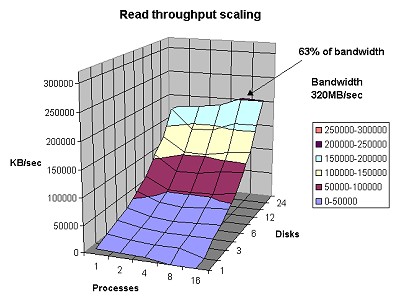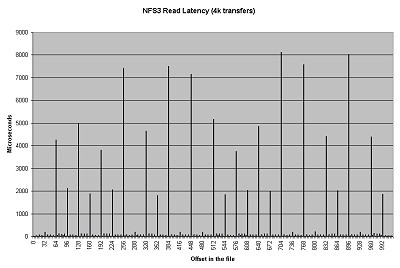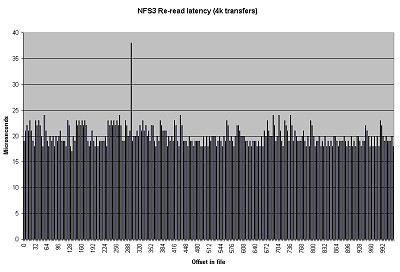iozone的确是一款不错的文件系统性能测试工具,可以就文件系统的很多方面作自动测试。地址:
www.iozone.org用法:
在希望进行测试的文件系统上运行:
/opt/iozone/bin/iozone -a
即可进行全面的自动测试,不过通常需要很长的时间,要耐心等待。
/opt/iozone/bin/iozone -a -i 1
只对write, rewrite进行性能测试
/opt/iozone/bin/iozone -a -i 1 -i 0
对读写进行性能测试
/opt/iozone/bin/iozone -a -g 1G -i 0 -i 1
对读写进行性能测试,并且最大测试文件为1G
/opt/iozone/bin/iozone -Ra
测试所有方面,并且生成excel文件
上面的命令在执行时,最好通过重定向保存到另外一个文件中.
/opt/iozone/bin/iozone –Rab output.wks
测试小文件
/opt/iozone/bin/iozone -a -s 512m -y 1k -q 8k -b minfile_result.xls
测试普通文件
如果2G内存测试,时间太长,先在grub.conf里把内存变成256m,这时使用512m的文件测试,就不会使用缓存了。
可以保证测试的准确性
/opt/iozone/bin/iozone -a -s 512m -y 8k -q 512k -b comfile_result.xls
测试大文件
/opt/iozone/bin/iozone -a -s 512m -y 1024k -q 10240k -i 0 -i 1 -i 2 -b largefile_result.xls
测试-i命令的使用
/opt/iozone/bin/iozone -Rab output.wks -g 1G -i 0 -i 1 -i 2 -i 8
-R 创建 Excel 报告
-g 设置自动模式下最大文件大小
Set maximum file size (in Kbytes) for auto mode.
-s 指定文件大小
-s 512k or -s 512M or -s 1G
-f filename
指定临时文件
-F filename filename filename
指定临时文件组
-t #
线程数
-q 指定最大记录大小
-q 512K or -q 512M or -q 1g
-y 指定最小记录大小
-y 512K or -q 512M or -q 1g
-U mountpoint
Mount point to unmount and remount between tests. Iozone will unmount and remount
this mount point before beginning each test. This guarantees that the buffer cache does not
contain any of the file under test.
通常情况下,测试的文件大小要求至少是系统cache的两倍以上,这样,测试的结果才是真是可信的。如果小于cache的两倍,文件的读写测试读写的将是cache的速度,测试的结果大打折扣。
http://blogold.chinaunix.net/u/12679/showart_421084.html
==========
IOzone是一个文件系统基准工具,它生成许多文件操作并执行测试。Iozone能够运行于许多平台。这份文档涵盖Iozone所执行的许多不同类型的操作和它的所有命令行参数。
Iozone执行以下操作测试文件I/O性能:
Read, write, re-read, re-write, read backwards, read strided, fread, fwrite, random read/write, pread/pwrite variants, aio_read, aio_write, mmap,
特征:
· 使用ANSI ‘C’编写.
· POSIX 异步I/O支持.
· Mmap() 文件I/O支持.
· 普通文件I/O支持.
· 单一流测试Single stream measurement.
· 多流测试Multiple stream measurement.
· 支持POSIX 线程.
· 多进程测试.
· 结果生成采用直观的Excel表格形式.
· I/O 延迟数据Latency data for plots.
· 兼容64位系统.
· 兼容大文件.
· 吞吐量测试中使用Stonewalling来避免不同步的问题.
· 可以配置处理器缓存大小.
· 可选择是否使用fsync, O_SYNC进行测试.
· 可以针对NFS进行测试.
编译IOzone
一旦你获得了IOzone的源码,你将拥有以下12个文件。
· iozone.c (源码)
· libasync.c (源码)
· makefile (makefile)
· libbif.c (源码)
· Iozone_msword_98.doc (Word格式文档)
· iozone.1 (nroff格式文档)
· gnuplot.dem (gnuplot示例文件)
· gnuplotps.dem (带附言的gnuplot示例文件)
· read_telemetry (用于telemetry读测试的示例文件)
· write_telemetry (用于telemetry写测试的示例文件)
· Run_rules.doc (程序运行规则)
· Changes.txt (Iozone开发版本升级记录)
键入:make
Makefile里有IOzone所支持的操作系统平台清单。选择其中符合你的配置的那个并
键入:make target
这就完成了。无须任何安装过程因为IOzone将自动在它的工作目录中产生所有文
件。你只要将IOzone拷贝到你想测试文件系统性能的任何一个文件夹并运行它。
或者你可以使用-f命令行参数来指定一个目标路径,例如,一个新文件系统中
的路径/文件名。
在你运行Iozone之前请阅读这份文档最后的运行规则。
运行Iozone的例子:
最简单的启动Iozone的方法是使用自动模式。
Iozone –a
如果你希望生成图表,你可以启用Excel模式。
Iozone –Ra (使用space和tab键分隔的输出可以被导入)
或者
Iozone –Rab output.wks (输出文件“output.wks”是一个二进制电子表格格式)
如果你的机器拥有大于512M的内存,你需要增大测试的最大文件大小至一个更大值。例如你的系统内存是1G,你该尝试如下:
Iozone –Ra –g 2G
如果你只在意读/写的性能,并不想花时间执行所有测试,你可以像如下一样限制测试内容:
Iozone –Ra –g 2G –i 0 –i 1
如果你想在一个NFS客户端上执行NFS上的Iozone你可以尝试这样用:
Iozone –Rac
这告诉Iozone在测试时将close()操作包括进来。如果客户端在运行NFS版本3时这可能是必需的。将close()操作包括进来将减少NFS版本3中的客户端缓存的影响。如果你使用比内存还大的文件进行测试,可以不使用‘c’标志。
关于各种测试的定义
Write: 测试向一个新文件写入的性能。当一个新文件被写入时,不仅仅是那些文件中的数据需要被存储,还包括那些用于定位数据存储在存储介质的具体位置的额外信息。这些额外信息被称作“元数据”。它包括目录信息,所分配的空间和一些与该文件有关但又并非该文件所含数据的其他数据。拜这些额外信息所赐,Write的性能通常会比Re-write的性能低。
Re-write: 测试向一个已存在的文件写入的性能。当一个已存在的文件被写入时,所需工作量较少,因为此时元数据已经存在。Re-write的性能通常比Write的性能高。
Read: 测试读一个已存在的文件的性能。
Re-Read: 测试读一个最近读过的文件的性能。Re-Read性能会高些,因为操作系统通常会缓存最近读过的文件数据。这个缓存可以被用于读以提高性能。
Random Read: 测试读一个文件中的随机偏移量的性能。许多因素可能影响这种情况下的系统性能,例如:操作系统缓存的大小,磁盘数量,寻道延迟和其他。
Random Write: 测试写一个文件中的随机偏移量的性能。同样,许多因素可能影响这种情况下的系统性能,例如:操作系统缓存的大小,磁盘数量,寻道延迟和其他。
Random Mix: 测试读写一个文件中的随机偏移量的性能。同样,许多因素可能影响这种情况下的系统性能,例如:操作系统缓存的大小,磁盘数量,寻道延迟和其他。这个测试只有在吞吐量测试模式下才能进行。每个线程/进程运行读或写测试。这种分布式读/写测试是基于round robin 模式的。最好使用多于一个线程/进程执行此测试。
Backwards Read: 测试使用倒序读一个文件的性能。这种读文件方法可能看起来很可笑,事实上,有些应用确实这么干。MSC Nastran是一个使用倒序读文件的应用程序的一个例子。它所读的文件都十分大(大小从G级别到T级别)。尽管许多操作系统使用一些特殊实现来优化顺序读文件的速度,很少有操作系统注意到并增强倒序读文件的性能。
Record Rewrite: 测试写与覆盖写一个文件中的特定块的性能。这个块可能会发生一些很有趣的事。如果这个块足够小(比CPU数据缓存小),测出来的性能将会非常高。如果比CPU数据缓存大而比TLB小,测出来的是另一个阶段的性能。如果比此二者都大,但比操作系统缓存小,得到的性能又是一个阶段。若大到超过操作系统缓存,又是另一番结果。
Strided Read: 测试跳跃读一个文件的性能。举例如下:在0偏移量处读4Kbytes,然后间隔200Kbytes,读4Kbytes,再间隔200Kbytes,如此反复。此时的模式是读4Kbytes,间隔200Kbytes并重复这个模式。这又是一个典型的应用行为,文件中使用了数据结构并且访问这个数据结构的特定区域的应用程序常常这样做。
许多操作系统并没注意到这种行为或者针对这种类型的访问做一些优化。同样,这种访问行为也可能导致一些有趣的性能异常。一个例子是在一个数据片化的文件系统里,应用程序的跳跃导致某一个特定的磁盘成为性能瓶颈。
Fwrite: 测试调用库函数fwrite()来写文件的性能。这是一个执行缓存与阻塞写操作的库例程。缓存在用户空间之内。如果一个应用程序想要写很小的传输块,fwrite()函数中的缓存与阻塞I/O功能能通过减少实际操作系统调用并在操作系统调用时增加传输块的大小来增强应用程序的性能。
这个测试是写一个新文件,所以元数据的写入也是要的。
Frewrite:测试调用库函数fwrite()来写文件的性能。这是一个执行缓存与阻塞写操作的库例程。缓存在用户空间之内。如果一个应用程序想要写很小的传输块,fwrite()函数中的缓存与阻塞I/O功能能通过减少实际操作系统调用并在操作系统调用时增加传输块的大小来增强应用程序的性能。
这个测试是写入一个已存在的文件,由于无元数据操作,测试的性能会高些。
Fread:测试调用库函数fread()来读文件的性能。这是一个执行缓存与阻塞读操作的库例程。缓存在用户空间之内。如果一个应用程序想要读很小的传输块,fwrite()函数中的缓存与阻塞I/O功能能通过减少实际操作系统调用并在操作系统调用时增加传输块的大小来增强应用程序的性能。
Freread: 这个测试与上面的fread 类似,除了在这个测试中被读文件是最近才刚被读过。这将导致更高的性能,因为操作系统缓存了文件数据。
几个特殊测试:
Mmap:许多操作系统支持mmap()的使用来映射一个文件到用户地址空间。映射之后,对内存的读写将同步到文件中去。这对一些希望将文件当作内存块来使用的应用程序来说很方便。一个例子是内存中的一块将同时作为一个文件保存在于文件系统中。
mmap 文件的语义和普通文件略有不同。如果发生了对内存的存储,并不是立即发生相应的文件I/O操作。使用MS_SYNC 和MS_ASYNC标志位的 msyc()函数调用将控制内存和文件的一致性。调用msync() 时将MS_SYNC置位将强制把内存里的内容写到文件中去并等待直到此操作完成才返回。而MS_ASYNC 置位则告诉操作系统使用异步机制将内存刷新到磁盘,这样应用程序可以直接返回而不用等待此操作的完成。
这个测试就是测量使用mmap()机制完成I/O的性能。
Async I/O: 许多操作系统支持的另外一种I/O机制是POSIX 标准的异步I/O。本程序使用POSIX标准异步I/O接口来完成此测试功能。
例如: aio_write(), aio_read(), aio_error()。这个测试测量POSIX异步I/O机制的性能。
命令行参数:
接下来解释每个参数的用法。
Usage: iozone [-s filesize_Kb] [-r record_size_Kb ] [-f [path]filename]
[-i test] [-E] [-p] [-a] [-A] [-z] [-Z] [-m] [-M] [-t children] [-h] [-o]
[-l min_number_procs] [-u max_number_procs] [-v] [-R] [-x]
[-d microseconds] [-F path1 path2...] [-V pattern] [-j stride]
[-T] [-C] [-B] [-D] [-G] [-I] [-H depth] [-k depth] [-U mount_point]
[-S cache_size] [-O] [-K] [-L line_size] [-g max_filesize_Kb]
[-n min_filesize_Kb] [-N] [-Q] [-P start_cpu] [-c] [-e] [-b filename]
[-J milliseconds] [-X filename] [-Y filename] [-w] [-W]
[-y min_recordsize_Kb] [-q max_recordsize_Kb] [-+m filename]
[-+u ] [ -+d ] [-+p percent_read] [-+r] [-+t ] [-+A #]
它们都是什么意思 ?
-a
用来使用全自动模式。生成包括所有测试操作的报告,使用的块 大小从4k到16M,文件大小从64k到512M。
-A
这种版本的自动模式提供更加全面的测试但是消耗更多时间。参数–a在文件不小于
32MB时将自动停止使用低于64K的块 大小测试。这节省了许多时间。而参数–A
则告诉Iozone你不介意等待,即使在文件非常大时也希望进行小块 的测试。
注意: 不推荐在Iozone3.61版中使用这个参数。使用–az –i 0 –i 1替代。
-b filename
Iozone输出结果时将创建一个兼容Excel的二进制格式的文件。
-B
使用mmap()文件。这将使用mmap()接口来创建并访问所有测试用的临时文件。一
些应用程序倾向于将文件当作内存的一块来看待。这些应用程序对文件执行mmap()
调用,然后就可以以读写内存的方式访问那个块来完成文件I/O。
-c
计算时间时将close()包括进来。This is useful only if you suspect that close() is
broken in the operating system currently under test. 对于NFS版本3测试而言这将会
很有用,同时它也能帮助我们识别nfs3_commit 是否正常工作。
-C
显示吞吐量测试中每个客户传输的字节数。如果你的操作系统在文件I/O或进程管
理方面存在饥饿问题时这将派上用场。
-d #
穿过“壁垒”时微秒级的延迟。在吞吐量测试中所有线程或进程在执行测试前都必
须挂起在一道“壁垒”之前。通常来说,所有线程或进程在同一时间被释放。这个
参数允许在释放每个进程或线程之间有一定的延迟(微秒级)。Microsecond delay out of barrier. During the throughput tests all threads or processes are
forced to a barrier before beginning the test.
-D
对mmap文件使用msync(MS_ASYNC) 。这告诉操作系统在mmap空间的所有数据
需要被异步地写到磁盘上。
-e
计算时间时将flush (fsync,fflush) 包括进来。
-E
用来进行一些扩展的测试。只在一些平台上可用。使用pread 接口。
-f filename
用来指定测试时使用的临时文件的文件名。当使用unmount参数时这将很有用。测试时在每个测试之间进行unmount的话,测试使用的临时文件在一个可以被卸载的文件夹中是很有必要的。卸载当前工作目录是不可能的,因为Iozone进程运行于此。
-F filename filename filename …
指定吞吐量测试中每个临时文件的文件名。文件名的数量应该和指定的进程或线程
数相同。
-g #
设置自动模式可使用的最大文件大小(Kbytes)。
-G
对mmap文件使用msync(MS_SYNC)。这告诉操作系统在mmap空间的所有数据
需要被同步地写到磁盘上。
-h
显示帮助。
-H #
使用POSIX异步I/O接口中的#号异步操作。Iozone使用POSIX 异步I/O接口,并使
用bcopy 从异步缓存拷贝回应用程序缓存。一些版本的MSC NASTRAN就是这么进
行I/O操作的。应用程序使用这一技术以便异步I/O可以在一个库中实现,而不需要
更改程序内模。
This technique is used by applications so that the async
I/O may be performed in a library and requires no changes to the applications internal model.
-i #
用来指定运行哪个测试。 (0=write/rewrite, 1=read/re-read, 2=random-read/write
3=Read-backwards, 4=Re-write-record, 5=stride-read, 6=fwrite/re-fwrite, 7=fread/Re-fread,
8=random mix, 9=pwrite/Re-pwrite, 10=pread/Re-pread, 11=pwritev/Re-pwritev, 12=preadv/Re-preadv).
总是需要先进行0号测试以便后面的测试有文件可以测试。
也支持使用-i # -i # -i # 以便可以进行多个测试。
-I
对所有文件操作使用VxFS VX_DIRECT 。告诉VXFS 文件系统所有对文件的操作将跨
过缓存直接在磁盘上进行。
-j #
设置访问文件的跨度为 (# * 块 大小). Stride read测试将使用这个跨度来读块 。
-J # (毫秒级)
在每个I/O操作之前产生指定毫秒的计算延迟。看 -X 和-Y来获取控制计算延
迟的其他参数。
-k #
Use POSIX async I/O (no bcopy) with # async operations. Iozone will use POSIX async
I/O and will not perform any extra bcopys. The buffers used by Iozone will be handed to
the async I/O system call directly.
-K
在普通测试时生成一些随机访问。
-l #
Set the lower limit on number of processes to run. When running throughput tests this
option allows the user to specify the least number of processes or threads to start. This
option should be used in conjunction with the -u option.
-L #
Set processor cache line size to value (in bytes). Tells Iozone the processor cache line size.
This is used internally to help speed up the test.
-m
Tells Iozone to use multiple buffers internally. Some applications read into a single
buffer over and over. Others have an array of buffers. This option allows both types of
applications to be simulated. Iozone’s default behavior is to re-use internal buffers.
This option allows one to override the default and to use multiple internal buffers.
-M
Iozone will call uname() and will put the string in the output file.
-n #
为自动模式设置最小文件大小(Kbytes)。
-N
报告结果以毫秒每操作的方式显示。
-o
写操作是同步写到磁盘的。 (O_SYNC). Iozone 会以O_SYNC 标志打开文件。这强制所有写操作完全写入磁盘后才返回测试。
-O
报告结果以操作每秒的方式显示。
-p
This purges the processor cache before each file operation. Iozone will allocate another
internal buffer that is aligned to the same processor cache boundary and is of a size that
matches the processor cache. It will zero fill this alternate buffer before beginning each test.
This will purge the processor cache and allow one to see the memory subsystem without
the acceleration due to the processor cache.
-P #
Bind processes/threads to processors, starting with this cpu #. Only available on some
platforms. The first sub process or thread will begin on the specified processor. Future processes or threads will be placed on the next processor. Once the total number of cpus is exceeded then future processes or threads will be placed in a round robin fashion.
-q #
设置自动模式下使用的最大块大小(Kbytes) 。也可以通过-q #k ( Kbytes) 或 -q #m ( Mbytes) 或 -q #g ( Gbytes)。设置最小块大小见 –y 。
-Q
Create offset/latency files. Iozone will create latency versus offset data files that can be
imported with a graphics package and plotted. This is useful for finding if certain offsets
have very high latencies. Such as the point where UFS will allocate its first indirect block.
One can see from the data the impacts of the extent allocations for extent based filesystems
with this option.
-r #
指定测试块 大小,K字节。也可以通过-r #k (Kbytes) 或 -r #m (Mbytes) 或 -r #g (Gbytes).
-R
生成Excel报告. Iozone将生成一个兼容Excel的标准输出报告。这个文件可以使用
Microsoft Excel打开,可以创建一个文件系统性能的图表。注意:3D图表是面向列
的。画图时你需要选择这项因为Excel默认处理面向行的数据。
-s #
指定测试文件大小,K字节。也可以通过-s #k (Kbytes) 或 -s #m (Mbytes) 或 -s #g (Gbytes).
-S #
Set processor cache size to value (in Kbytes). This tells Iozone the size of the processor cache.
It is used internally for buffer alignment and for the purge functionality.
-t #
以吞吐量模式运行Iozone。这一选项允许用户指定测试时使用多少个线程或者进程。
-T
吞吐量测试时使用POSIX线程。仅在兼容POSIX线程的平台上可用。
-u #
Set the upper limit on number of processes to run. When running throughput tests this
option allows the user to specify the greatest number of processes or threads to start.
This option should be used in conjunction with the -l option.
-U mountpoint
在测试之间卸载并重新挂载挂载点。这保证了缓存cache不包含任何测试过的文件。
-v
显示Iozone的版本号。
-V #
Specify a pattern that is to be written to the temporary file and validated for accuracy in
each of the read tests.
-w
当临时文件使用完毕时不删除它们。把它们留在文件系统中。
-W
读或写时锁文件。
-x
关闭“stone-walling”. Stonewalling 是 Iozone内部使用的一种技术。它是在进行吞吐量测试时使用的。程序启动所有线程或进程然后将它们暂停在“壁垒”前。
一旦它们都做好准备工作,它们将被同时释放。当其中任何一个线程或进程完成工作,整个测试就终止了并计算到达这个点时所有I/O的吞吐量。这保证了整个测试进行时所有的进程和线程都是并行的。这个标志位允许取消 stonewalling并看看会发生什么。
-X filename
Use this file for write telemetry information. The file contains triplets of information:
Byte offset, size of transfer, compute delay in milliseconds. This option is useful if one has
taken a system call trace of the application that is of interest. This allows Iozone to replicate the I/O operations that this specific application generates and provide benchmark results for this file behavior. (if column 1 contains # then the line is a comment)
-y #
设置自动模式下使用的最小块大小(Kbytes) 。也可以通过-y #k ( Kbytes) 或 -y #m ( Mbytes) 或 -y #g ( Gbytes)。设置最大块大小见 –y 。
-Y filename
Use this file for read telemetry information. The file contains triplets of information:
Byte offset, size of transfer, compute delay in milliseconds. This option is useful if one has
taken a system call trace of the application that is of interest. This allows Iozone to replicate the I/O operations that this specific application generates and provide benchmark results for this file behavior. (if column 1 contains # then the line is a comment)
-z
Used in conjunction with -a to test all possible record sizes. Normally Iozone omits testing
of small record sizes for very large files when used in full automatic mode. This option forces
Iozone to include the small record sizes in the automatic tests also.
-Z
启动混合 mmap I/O 和文件 I/O.
-+m filename
Use this file to obtain the configuration information of the clients for cluster testing. The file contains one line for each client. Each line has three fields. The fields are space delimited. A # sign in column zero is a comment line. The first field is the name of the client. The second field is the path, on the client, for the working directory where Iozone will execute. The third field is the path, on the client, for the executable Iozone.
To use this option one must be able to execute commands on the clients without being challenged for a password. Iozone will start remote execution by using “rsh”.
-+u
Enable CPU utilization mode.
-+d
启动诊断模式。在这一模式下每个字节都将被验证。这在怀疑I/O子系统出错时有用。
-+p percent_read
Set the percentage of the thread/processes that will perform random read testing. Only valid in throughput mode and with more than 1 process/thread.
-+r
Enable O_RSYNC and O_SYNC for all I/O testing.
-+t
启动网络性能测试。需要 -+m
-+A
Enable madvise. 0 = normal, 1=random, 2=sequential, 3=dontneed, 4=willneed.
For use with options that activate mmap() file I/O. See: -B
http://blog.csdn.net/ps_e_udo/archive/2009/05/03/4145156.aspx
===========
以下内容转自官方首页:http://www.iozone.org/
IOzone Filesystem Benchmark

IOzone is a filesystem benchmark tool. The benchmark generates and measures a variety of file operations. Iozone has been ported to many machines and runs under many operating systems. Iozone is useful for performing a broad filesystem analysis of a vendor’s computer platform. The benchmark tests file I/O performance for the following operations: Read, write, re-read, re-write, read backwards, read strided, fread, fwrite, random read, pread ,mmap, aio_read, aio_write |  |

Benchmark Features: - ANSII C source
- POSIX async I/O
- Mmap() file I/O
- Normal file I/O
- Single stream measurement
- Multiple stream measurement
- Distributed fileserver measurements (Cluster)
- POSIX pthreads
- Multi-process measurement
- Excel importable output for graph generation
- Latency plots
- 64bit compatible source
- Large file compatible
- Stonewalling in throughput tests to eliminate straggler effects
- Processor cache size configurable
- Selectable measurements with fsync, O_SYNC
- Builds for: AIX, BSDI, HP-UX, IRIX, FreeBSD, Linux, OpenBSD, NetBSD, OSFV3, OSFV4, OSFV5, SCO OpenServer, Solaris, MAC OS X, Windows (95/98/Me/NT/2K/XP)
| While computers are typically purchased with an application in mind it is also likely that over time the application mix will change. Many vendors have enhanced their operating systems to perform well for some frequently used applications. Although this accelerates the I/O for those few applications it is also likely that the system may not perform well for other applications that were not targeted by the operating system. An example of this type of enhancement is: Database. Many operating systems vendors have tested and tuned the filesystem so it works well with databases. While the database users are happy, the other users may not be so happy as the entire system may be giving all of the system resources to the database users at the expense of all other users. As time rolls on the system administrator may decide that a few more office automation tasks could be shifted to this machine. The load may now shift from a random reader application (database) to a sequential reader. The users may discover that the machine is very slow when running this new application and become dissatisfied with the decision to purchase this platform. By using Iozone to get a broad filesystem performance coverage the buyer is much more likely to see any hot or cold spots and pick a platform and operating system that is more well balanced. |
The NFS3 Read Latency graph shows the latency of 4k read operations over an NFS Version 3 filesystem mounted on a client running Iozone. Click on image for a larger view. |  |

| The NFS3 Re-read Latency graph shows the re-read latency of 4k reads over an NFS Version 3 filesystem. One can clearly see the effects of the client side cache. Here the latencies are the same as local buffer cache latencies. Click on image for larger view. |
Download Documentation: [ PDF ] [ Postscript gzip ] [ MS Word Doc ]
Download Source:
[Latest tarball] [Latest files] [Stable tarball] [Stable files]
[Linux SRPM ]
[Linux i386 RPM ]
[Windows ]
[Contact capps@iozone.org to purchase the Excel spreadsheet with extensive Visual Basic macros to automatically generate the 3D graphs. Click to see the example output. ]
Typical Linux result example with annotations.
(Click on tabs at the bottom of the graph to see all of the results):
Linux Iozone graph example.
Typical Windows2000 result example with annotations.
(Click on tabs at the bottom of the graph to see all of the results):
Windows 2000 Iozone graph example.
Apple's Xserver.
(Click on tabs at the bottom of the graph to see all of the results):
Apple's Xserver.
Comparisions of various filesystem types.
(Click on tabs at the bottom of the graph to see all of the results):
File system comparisons.
NFS Presentation:
Powerpoint: NFS PowerPoint presentation.
MS Word: NFS MS Word presentation.
PDF : Revised NFS Client performance presentation.
MS Excel: NFS Throughput example.
Questions: email capps@iozone.org
Interested in NFSV4 ?: NFSV4 info
Iozone Lab Tour 1: Click Here
Iozone Lab Tour 2: Click Here
Don't forget to tryout the new "fileop" that is included in the Iozone kit.
Fileop graph example.
The Windows version of Iozone uses the Cygwin runtime. The sources for this may be obtained by clicking on the link below. However, I strongly recommend that the user visit http://www.cygwin.com and obtain everything from the original site. They have great stuff there and you'll thank me :-)
Cygwin DLL source code
I also volunteer at a special needs school. They are a non-profit school for special needs children (K->12). The link below is a quick ref and contact list for the school. (Any donations would be very welcome :-)
Great Lakes Academy.
Last Updated: Oct 28th 16:00:00 EST 2006
webmaster@iozone.org
